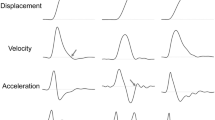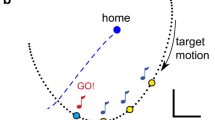Abstract
Despite the abundant experimental evidence for the irregular, multipeaked velocity profiles that often characterize rapid human limb movements, there is currently little agreement on how to interpret these phenomena. While in some studies these irregularities have been interpreted as reflecting a continuous control process, in others the irregularities are considered to be evidence for the existence of discrete movement primitives that are initiated by an intermittent controller. Here we introduce a novel “soft symmetry” method for analyzing irregular movements and decomposing them into their discrete movement primitives. We applied this method to analyze rapid pronation/supination wrist movements in monkeys during a one-dimensional tracking task. We showed that the properties of the extracted overlapping submovements (OSMs) were very similar to those of single, regular movements, despite the fact that the decomposition algorithm did not restrict the extracted submovements to a particular shape. In addition we showed that the movement primitives corrected preceding primitives and that the correction initiation time was highly variable, and thus could not be explained by the relatively fixed sensorimotor delay. These results argue against the interpretation of movement irregularities as reflecting a continuous control process and reinforce the hypothesis that movement irregularities result from an intermittent control mechanism. Demonstrating these phenomena in non-human primates will allow neurophysiological investigation of the neural mechanisms involved in these corrections.










Similar content being viewed by others
References
Abend W, Bizzi E, Morasso P (1982) Human arm trajectory formation. Brain 105:331–348
Atkeson CG, Hollerbach JM (1985) Kinematic features of unrestrained vertical arm movements. J Neurosci 5:2318–2330
Berthier NE (1996) Learning to reach: a mathematical model. Dev Psychol 32:811–823
Berthier NE (1997) Analysis of reaching for stationary and moving objects in the human infant. In: Donahue JDVP (ed) Neural network models of complex behavior—biobehavioral foundations. North-Holland, Amsterdam, pp 283–301
Bhushan N, Shadmehr R (1999) Computational nature of human adaptive control during learning of reaching movements in force fields. Biol Cybern 81:39–60
Burdet E, Milner TE (1998) Quantization of human motions and learning of accurate movements. Biol Cybern 78:307–318
Crossman ERFW, Goodeve PJ (1983) Feedback-control of hand-movement and Fitts law. Q J Exp Psychol A 35:251–278
Engelbrecht SE, Berthier NE, O’Sullivan LP (2003) The undershoot bias: learning to act optimally under uncertainty. Psychol Sci 14:257–261
Flash T, Henis E (1991) Arm trajectory modifications during reaching towards visual targets. J Cogn Neurosci 3:220–230
Flash T, Hogan N (1985) The coordination of arm movements: an experimentally confirmed mathematical model. J Neurosci 5:1688–1703
Gordon J, Ghez C (1987) Trajectory control in targeted force impulses. III. Compensatory adjustments for initial errors. Exp Brain Res 67:253–269
Gordon J, Ghilardi MF, Ghez C (1994) Accuracy of planar reaching movements. I. Independence of direction and extent variability. Exp Brain Res 99:97–111
Hanneton S, Berthoz A, Droulez J, Slotine JJ (1997) Does the brain use sliding variables for the control of movements?. Biol Cybern 77:381–393
Harris CM (1995) Does saccadic undershoot minimize saccadic flight-time? A Monte-Carlo study. Vision Res 35:691–701
Harris CM, Wolpert DM (1998) Signal-dependent noise determines motor planning. Nature 394:780–784
Houk JC, Singer JJ, Goldman MR (1970) An evaluation of length and force feedback to soleus muscles of decerebrate cats. J Neurophysiol 33:784–811
Houk JC, Barto AG, Fagg AH (2000) Fractional power damping model of joint motion. In: Latash ML (ed) Progress in motor control: structure-function relations in voluntary movements, vol 2. Human Kinetics, Champaign, IL, pp 147–178
Jones KE, Hamilton AF, Wolpert DM (2002) Sources of signal-dependent noise during isometric force production. J Neurophysiol 88:1533–1544
Karniel A, Inbar GF (1999) The use of a non-linear muscle model in explaining the relationship between duration, amplitude, and peak velocity of human rapid movements. J Mot Behav 31:203–206
Kawato M (1992) Optimization and learning in neural networks for formation and control of coordinated movement. In: Meyer DE, Kornblum S (eds) Attention and performance, vol XIV. MIT Press, Cambridge, MA, pp 821–849
Kositsky M, Barto AG (2001) Emergence of multiple movement units in the presence of noise and feedback delay. In: Dietterich TG, Becker Z, Ghahramani Z (eds) Advances in neural information processing systems 14. MIT Press, Cambridge
Krakauer JW, Gordon J, Veytsman M, Ghez C (2002) Contributions of planning and updating to accuracy of reaching movements in normals and stroke. In: Society for Neuroscience, vol Program No. 169.4
Krebs HI, Aisen ML, Volpe BT, Hogan N (1999) Quantization of continuous arm movements in humans with brain injury. Proc Natl Acad Sci U S A 96:4645–4649
Lee D, Port NL, Georgopoulos AP (1997) Manual interception of moving targets. 2. On-line control of overlapping submovements. Exp Brain Res 116:421–433
Messier J, Kalaska JF (1999) Comparison of variability of initial kinematics and endpoints of reaching movements. Exp Brain Res 125:139–152
Meyer DE, Abrams RA, Kornblum S, Wright CE, Smith JE (1988) Optimality in human motor performance: ideal control of rapid aimed movements. Psychol Rev 95:340–370
Milner TE (1992) A model for the generation of movements requiring endpoint precision. Neuroscience 49:487–496
Milner TE, Ijaz MM (1990) The effect of accuracy constraints on three-dimensional movement kinematics. Neuroscience 35:365–374
Morasso P (1981) Spatial control of arm movements. Exp Brain Res 42:223–227
Morasso P, Mussa Ivaldi FA (1982) Trajectory formation and handwriting: a computational model. Biol Cybern 45:131–142
Nagasaki H (1989) Asymmetric velocity and acceleration profiles of human arm movements. Exp Brain Res 74:319–326
Novak KE, Miller LE, Houk JC (2000) Kinematic properties of rapid hand movements in a knob turning task. Exp Brain Res 132:419–433
Novak KE, Miller LE, Houk JC (2002) The use of overlapping submovements in the control of rapid hand movements. Exp Brain Res 144:351–364
Pratt J, Chasteen AL, Abrams RA (1994) Rapid aimed limb movements—age-differences and practice effects in component submovements. Psychol Aging 9:325–334
Rohrer B, Hogan N (2003) Avoiding spurious submovement decompositions: a globally optimal algorithm. Biol Cybern 89:190–199
Saunders JA, Knill DC (2003) Humans use continuous visual feedback from the hand to control fast reaching movements. Exp Brain Res 152:341–352
Shadmehr R, Mussa-Ivaldi FA (1994) Adaptive representation of dynamics during learning of a motor task. J Neurosci 14:3208–3224
Todorov E, Jordan MI (2002) Optimal feedback control as a theory of motor coordination. Nat Neurosci 5:1226–1235
Uno Y, Kawato M, Suzuki R (1989) Formation and control of optimal trajectory in human multijoint arm movement. Minimum torque-change model. Biol Cybern 61:89–101
Wiegner AW, Wierzbicka MM (1992) Kinematic models and human elbow flexion movements: quantitative analysis. Exp Brain Res 88:665–673
Woodworth RS (1899) The accuracy of voluntary movement. Psychol Rev 3:1–114
Wu C-H, Houk JC, Young KY, Miller LE (1990) Nonlinear damping of limb motion. In: Winters JM, Woo SL-Y (eds) Multiple muscle systems: biomechanics and movement organization. Springer Heidelberg Berlin New York, pp 214–235
Author information
Authors and Affiliations
Corresponding author
Rights and permissions
About this article
Cite this article
Fishbach, A., Roy, S.A., Bastianen, C. et al. Kinematic properties of on-line error corrections in the monkey. Exp Brain Res 164, 442–457 (2005). https://doi.org/10.1007/s00221-005-2264-3
Received:
Accepted:
Published:
Issue Date:
DOI: https://doi.org/10.1007/s00221-005-2264-3




